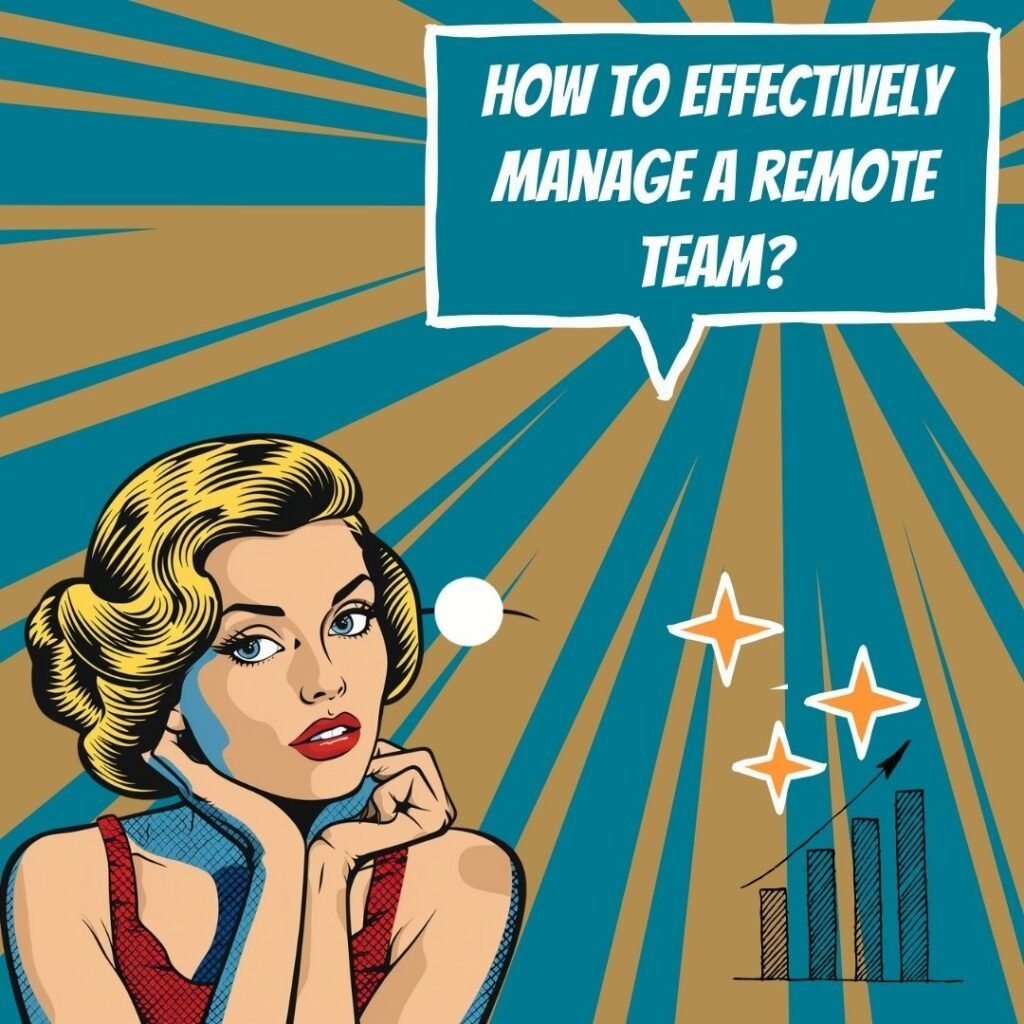Key Takeaways
✅ Establishing Trust and Collaboration: Maintaining open communication and setting clear expectations helps build trust. Use regular check-ins, assume positive intent, and document procedures to keep everyone aligned and accountable.
✅ Maintaining Company Culture: Define and communicate your company values. Provide tools for collaboration and support personal growth to foster a culture that aligns with your mission.
✅ Managing Productivity and Performance: Track progress with performance metrics and set realistic goals. Give regular feedback and recognize accomplishments to keep remote teams motivated and on task.

Introduction
What makes remote team management so challenging, and why is it more important than ever to navigate these hurdles effectively? With many companies transitioning to remote work, managers must address common obstacles like communication and collaboration. Popular fears about remote work include declining productivity and loss of company culture. Yet, with the right strategies, managers can turn these challenges into opportunities.
Modern trends emphasize using video conferencing tools, setting clear expectations, and fostering an inclusive environment. By uncovering actionable insights in this article, you'll learn how to maximize productivity and build a cohesive team despite the physical distance.
Top Statistics
| Top Statistics | Insight |
|---|---|
| Companies that communicate more effectively are 4.5 times more likely to retain the best employees. | Effective communication is crucial in remote settings to avoid misunderstandings and ensure everyone is on the same page. |
| 83% of professionals depend on technology to collaborate. | Digital tools are the lifeblood of remote collaboration, making it essential for companies to invest in reliable and user-friendly platforms. |
| 27% of employees who plan to leave within the first year cite feeling “disconnected” from the organization. | A sense of connection and belonging is vital for retention, especially in remote teams where face-to-face interaction is limited. |
| Employees engaged in strong team-building activities are more productive. | Regular team-building exercises can boost morale and improve collaboration among remote workers. |
| Management statistics are essential in understanding how well a company and its employees perform. | Constantly evaluating management practices helps identify areas for improvement and drives overall performance. |
Challenges of Communication and Collaboration
Maintaining good communication and collaboration is a significant challenge for remote teams. It's easy for messages to get lost in translation, leading to misunderstandings and inefficiencies. How can teams tackle this? Solutions such as video conferencing, phone calls, chat, or instant messaging can bridge the gap. Regularly scheduled meetings and check-ins also help ensure everyone is on the same page. Are your teams using the best tools to stay connected?
Building Trust and Overcoming Lack of Trust
Trusting remote employees to be productive is a common concern among managers. This often stems from not being able to physically see the team's efforts. So, how can managers overcome this lack of trust? By objectively measuring productivity through KPIs and metrics and using employee productivity monitoring software, managers can gain better insight. Fostering a culture of trust involves setting clear expectations and keeping transparent communication lines open. Is your organization investing in building this trust?
Establishing Company Culture
Creating a strong company culture within remote teams can be especially tough. The physical distance makes it hard to instill a sense of shared values and ideals. Solutions include having a strong mission statement and vision that everyone can rally around. Clearly communicating these values and showing commitment can foster a sense of purpose and belonging. Are your remote employees connected to your company's mission?
Managing Personal Distractions and Productivity
Remote employees often face numerous personal distractions at home, ranging from family members to pets. Addressing these distractions upfront by setting clear goals and expectations helps employees remain focused. Implementing structured coordination and regular check-ins can also ensure productivity. Are you providing the necessary support to help your team manage their remote work environment?
Addressing Cultural Diversity and Inclusion
Cultural diversity presents unique challenges and opportunities for remote teams. How should companies handle this? Embracing curiosity, adapting communication styles, and providing cross-cultural training are vital. Avoiding stereotypes and fostering an inclusive environment can promote a supportive workspace for all. Is your team leveraging its cultural diversity?
Coordinating Schedules and Overcoming Time Zone Differences
Coordinating schedules across different time zones remains a persistent challenge for remote teams. Solutions include creating and regularly updating resources such as shared calendars. Utilizing collaboration tools and recording meetings for later viewing ensures that everyone stays informed. Are your teams effectively overcoming these time zone hurdles?
AI Marketing Engineers Recommendation
Recommendation 1: Embrace Flexible Work Hours: In the realm of remote team management, flexible work hours have proven to enhance productivity and employee satisfaction. According to a study by Buffer, 40% of remote workers cited flexible schedules as the biggest benefit of working remotely. This approach allows team members to work during their most productive hours, accommodating differing time zones and personal commitments. Implementing core working hours where all team members are available for collaboration can ensure cohesion while respecting individual preferences.
Recommendation 2: Leverage Communication Tools Efficiently: Effective communication remains a cornerstone of successful remote teams. Recent trends point to a significant increase in the use of platforms like Slack, Microsoft Teams, and Zoom. The strategic use of communication tools can streamline workflows and reduce misunderstandings. In 2020, Microsoft Teams saw a usage surge of 894%, highlighting the growing reliance on such platforms. To optimize communication, set clear guidelines on when and how to use each tool—reserve email for formal communication, instant messaging for quick queries, and video calls for detailed discussions.
Recommendation 3: Implement Regular Virtual Check-Ins: Regular virtual check-ins are crucial in maintaining team coherence and morale. Weekly or bi-weekly meetings via Zoom or Google Meet can help address issues promptly and keep team members aligned with company goals. A Gallup poll suggests that employees who regularly communicate with their managers are three times more likely to be engaged. Incorporate brief, optional social interactions before or after these meetings to foster a sense of belonging and mitigate isolation, a common challenge in remote work environments.
Relevant Links
- Best Tools for Effective Remote Team Communication
- How KPIs and Metrics Can Foster Trust in Remote Teams
- Building a Strong Company Culture in Remote Teams
- How to Enhance Productivity in Remote Work Environments
- Harnessing Cultural Diversity for Enhanced Team Collaboration
Conclusion
Navigating the complexities of remote team management is no small feat, but the right strategies can make all the difference. Effective communication and collaboration tools are indispensable in bridging the gap that physical distance creates. Managers can turn to video conferencing and regularly scheduled meetings to keep everyone aligned. Building and maintaining trust is essential, and this can be achieved by measuring productivity through KPIs and fostering transparent communication.
Cultivating a strong company culture remotely involves clear mission statements and shared values that resonate with the team. Addressing personal distractions and productivity issues upfront, alongside regular check-ins, ensures employees stay on track. Additionally, embracing cultural diversity and inclusion requires sensitivity and adaptability, including cross-cultural training and avoiding stereotypes. Finally, coordinating schedules across different time zones necessitates the use of collaboration tools and resource updates.
In sum, the key to successful remote team management lies in a balanced approach of clear communication, trust-building, culture-fostering, and inclusivity. As remote work continues to evolve, these strategies will remain crucial for organizations looking to thrive in a dispersed yet connected world.
FAQs
Question 1: What are the key challenges in managing remote teams?
Answer: Managing remote teams requires extra efforts to understand team dynamics, ensure effective communication, and maintain employee engagement and motivation.
Question 2: What skills are required for remote team management?
Answer: Remote team management requires skills such as over-communication, clarifying expectations, assertiveness, proactivity, and adaptability.
Question 3: How can managers ensure remote employees feel included?
Answer: Managers can ensure remote employees feel included by maintaining regular check-ins, using collaborative tools, and encouraging open communication.
Question 4: How can managers optimize remote work setups?
Answer: Managers can optimize remote work setups by asking about equipment needs, technology issues, and workflow improvements.
Question 5: What strategies can managers use to prevent burnout?
Answer: Managers can prevent burnout by setting clear goals, encouraging breaks, and monitoring work-life balance.
Question 6: How can managers ensure remote meetings are effective?
Answer: Managers can ensure remote meetings are effective by using video conferencing tools, encouraging active participation, and sending follow-up emails.
Question 7: What questions should managers ask remote employees?
Answer: Managers should ask questions about daily routines, challenges, and preferences to better understand and support remote employees.
Question 8: How often should managers hold one-on-one meetings with remote employees?
Answer: Managers should hold one-on-one meetings with remote employees at least once a week to maintain regular communication and address any concerns.
Question 9: What tools can managers use to facilitate remote communication?
Answer: Managers can use tools like Asana, Slack, Trello, and video conferencing software to facilitate remote communication and collaboration.
Academic References
- Remote Working and Work Effectiveness: A Leader Perspective (2020). Journal of Management Studies, 57(6), 823-856. This study examines the perceived effectiveness of remote work from the perspective of managers, highlighting the benefits and limitations of remote work and how they impact work outcomes and collaboration.
- The Perils and Opportunities of Remote Teamwork (2019). Team Performance Management, 25(4), 217-232. This article discusses the challenges and opportunities of remote teamwork, emphasizing the importance of formalizing long-term objectives and processes to ensure alignment and effective collaboration in remote teams.
- Challenges and Barriers in Virtual Teams: A Literature Review (2018). International Journal of Management Reviews, 20(2), 199-217. This literature review highlights the challenges faced by virtual teams, including the management of team effort, cultural differences, and the need for structured understandings to facilitate collaboration.
- Remote Work: Challenges and Strategies for Effective Management (2020). Journal of Organizational Behavior, 41(7), 577-591. This study explores the complexities of remote work and proposes management methods to address its issues, focusing on strategies for effective remote team management.
- The Challenges of Leading Remote Teams and Its Influence on Strategies for Success (2021). Leadership Quarterly, 32(4), 101-121. This research examines the challenges of leading distributed teams and suggests solutions, providing insights into the specific challenges faced by remote team leaders and strategies for overcoming them.











